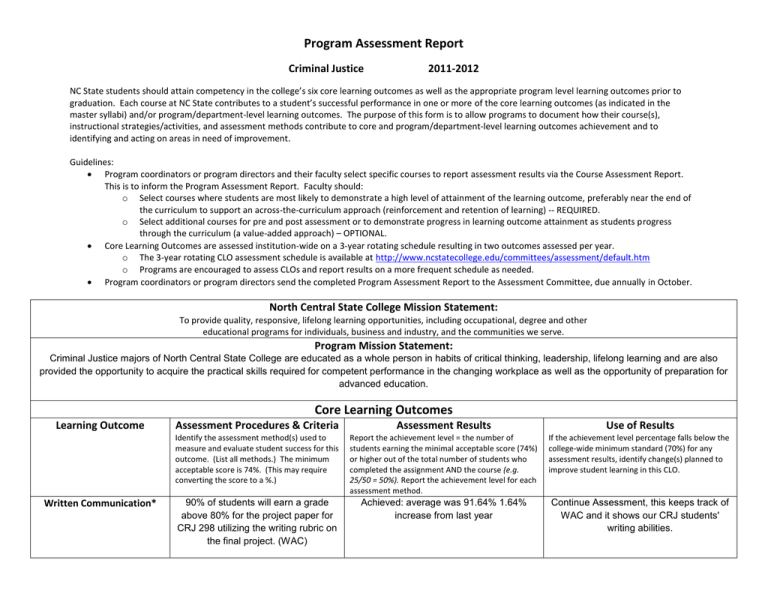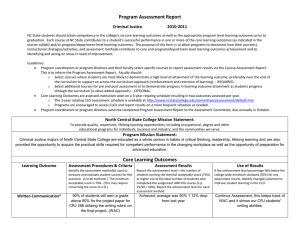Program Assessment Report Criminal Justice 2011-2012
advertisement

Program Assessment Report Criminal Justice 2011-2012 NC State students should attain competency in the college’s six core learning outcomes as well as the appropriate program level learning outcomes prior to graduation. Each course at NC State contributes to a student’s successful performance in one or more of the core learning outcomes (as indicated in the master syllabi) and/or program/department-level learning outcomes. The purpose of this form is to allow programs to document how their course(s), instructional strategies/activities, and assessment methods contribute to core and program/department-level learning outcomes achievement and to identifying and acting on areas in need of improvement. Guidelines: Program coordinators or program directors and their faculty select specific courses to report assessment results via the Course Assessment Report. This is to inform the Program Assessment Report. Faculty should: o Select courses where students are most likely to demonstrate a high level of attainment of the learning outcome, preferably near the end of the curriculum to support an across-the-curriculum approach (reinforcement and retention of learning) -- REQUIRED. o Select additional courses for pre and post assessment or to demonstrate progress in learning outcome attainment as students progress through the curriculum (a value-added approach) – OPTIONAL. Core Learning Outcomes are assessed institution-wide on a 3-year rotating schedule resulting in two outcomes assessed per year. o The 3-year rotating CLO assessment schedule is available at http://www.ncstatecollege.edu/committees/assessment/default.htm o Programs are encouraged to assess CLOs and report results on a more frequent schedule as needed. Program coordinators or program directors send the completed Program Assessment Report to the Assessment Committee, due annually in October. North Central State College Mission Statement: To provide quality, responsive, lifelong learning opportunities, including occupational, degree and other educational programs for individuals, business and industry, and the communities we serve. Program Mission Statement: Criminal Justice majors of North Central State College are educated as a whole person in habits of critical thinking, leadership, lifelong learning and are also provided the opportunity to acquire the practical skills required for competent performance in the changing workplace as well as the opportunity of preparation for advanced education. Core Learning Outcomes Learning Outcome Written Communication* Assessment Procedures & Criteria Assessment Results Use of Results Identify the assessment method(s) used to measure and evaluate student success for this outcome. (List all methods.) The minimum acceptable score is 74%. (This may require converting the score to a %.) Report the achievement level = the number of students earning the minimal acceptable score (74%) or higher out of the total number of students who completed the assignment AND the course (e.g. 25/50 = 50%). Report the achievement level for each assessment method. If the achievement level percentage falls below the college-wide minimum standard (70%) for any assessment results, identify change(s) planned to improve student learning in this CLO. 90% of students will earn a grade above 80% for the project paper for CRJ 298 utilizing the writing rubric on the final project. (WAC) Achieved: average was 91.64% 1.64% increase from last year Continue Assessment, this keeps track of WAC and it shows our CRJ students' writing abilities. Speech* 80% of students will receive a satisfactory score rating on the oral communication rubric/presentation in CRJ225 (close to graduation class) CRJ225 class average was 89% (18 students evaluated) 2% increase Compared a 100 level to a 200 level class using the SAC rubric. The difference was (100class-72%, 200class-89%), This is a growth from last year: Continue to use next year because this shows the growth between 1st and 2nd year students in their oral communication skills. 1st week's score was 52% and finals week score was 92% Increase of 42%. Achieved goal Continue for next year. The rubric is an excellent tool to use to measure critical thinking and this measurement was designed to be used nationally This was the perfect assignment to conduct this on. This is also a first year course. “Will compare these SAC scores with CRJ113, 100 level class for comparison” Information Literacy* Data Method/Collection Planned for 2011-12 for this reporting mechanism Critical Thinking* Utilize the critical thinking rubric in class CRJ180 during the first week on the assignment "What would you do?". Administer it again for the same assignment during finals week. At least a 20% increase should occur or maintain an average at 80% or above Intercultural Knowledge/Competence* Data Method/Collection Planned for 2011-12 for this reporting mechanism No CRJ Courses were used by the Math dept. this year Computation Proficiency** *Rubrics are available on the Assessment of Student Learning Committee web site at http://www.ncstatecollege.edu/committees/assessment/default.htm. These rubrics may be used as is or modified, or another rubric or assessment method may be substituted. **After semester conversion, programs should report assessment results from the highest college math course in the curriculum (comprehensive final exam scores) as well assessment results that occur in non-math program courses where computation is considered to be important to the technology/profession (e.g. drug calculations in a nursing curriculum). Program-Level Learning Outcomes (add rows as needed) CRJ Program Learning Outcome Assessment Procedures & Criteria Assessment Results Use of Results Enter outcomes below; add rows as needed. Identify the assessment method(s) used to measure and evaluate student success for this outcome. (List all methods.) State the minimum acceptable score for each method. Report the achievement level = the number of students attaining the minimum acceptable score or higher out of the total number of students who completed the assignment AND the course (e.g. 25/50 = 50%). State the program’s minimum achievement level percentage and report the achievement level attained for each assessment If the achievement level percentage falls below the program’s minimum standard for any assessment results, identify change(s) planned to improve student learning in this learning outcome. method. By the end of the Associate's Degree program students will be able to: A. Understand all core criminal justice foundations including juvenile justice, criminology, constitutional law, corrections, private security, and US Judicial and Criminal Justice systems. B. Demonstrate the ability to communicate effectively in writing and speech through casework, group projects, and on the job training. C. Demonstrate well- A1 25% increase in the average of the post-test scores from the pre-test scores in CRJ 140 and CRJ 145. Given at beginning of courses and end of courses CRJ140-32% increase CRJ145-35% 140 was an increase and 145 a small decrease Continue this assessment because it shows the level of understanding of our core outcomes in our 1st year students/CRJ program A2. 30% increase in the average of the post-test scores from the pre-test scores in the comprehensive program test administered first in CRJ 145 and then in CRJ 298/295/226. 39% increase (goal was attained) Continue and use as comparative data. B1. 90% of students will earn a grade of P (Pass) for writing assignments for CRJ 298 utilizing the writing rubric on the final project. Achieved: average was 91.64% 1.64% increase from last year Continue Assessment, this keeps track of WAC and it shows our CRJ students' writing abilities. B2. 80% of students will receive an above satisfactory rating on their performance evaluation from the site supervisor at the end of CRJ 298. Achieved: 100% Continue Assessment, because this shows our students' ability to be able to work in the real world and their ability to communicate effectively with others. B3. 85% of students completing CRJ 115 (CJ report writing) will earn a grade of C or above. Completed/Attained Goal, very minor decrease in overall scores from last year Continue assessment because it shows students' writing abilities. C1. 85% of students will receive a Achieved:100% Continue assessment for next year developed analytical and problem solving skills within core criminal justice foundation coursework. D. Demonstrate the proper standards of criminal justice professionalism, morals, and ethics grade of satisfactory on the analytical and problem solving skills assignment in CRJ 298. C2. 80% of students will receive a satisfactory grade on problem solving skill rubric for CRJ 175 and the skill questions in CRJ 140. 88% CRJ175 and 91% for CRJ140 (small increase in both) Continue for next year. C3. Utilize the critical thinking rubric in class CRJ180 during the first week on the assignment "What would you do?". Administer it again for the same assignment during finals week. At least a 20% increase should occur or maintain an average at 80% or above 1st week's score was 52% and finals week score was 92% Increase of 42%. Achieved goal Continue for next year. The rubric is an excellent tool to use to measure critical thinking and this measurement was designed to be used nationally This was the perfect assignment to conduct this on. This is also a first year course. D1. 80% of students will receive an above satisfactory rating on their performance evaluation from the site supervisor at the end of CRJ 298. Achieved: 100% Continue for next year. D2. 85% of students will receive a grade of C or above on the moral/ethical skill rubric for CRJ 282 and CRJ 298. Achieved in both courses. Continue for next year.
